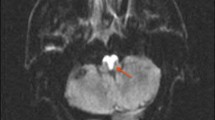Abstract
Understanding the risks of contrast-induced encephalopathy (CIE), a serious complication of contrast agents, is crucial in endovascular treatment. We present the case of a 73-year-old woman who developed CIE in the medulla and cervical cord during coil embolization for unruptured left basilar-superior cerebellar artery and basilar artery tip aneurysms. The CIE was identified via neuromonitoring. In this case, spinal cord ischemia might have occurred due to reduced perfusion pressure after inserting the distal access catheter (DAC) in the vertebral artery. Multiple injections of contrast medium via the DAC during coil embolization likely contributed to an unusual form of CIE. Extreme caution is warranted during endovascular treatments involving the posterior circulation, due to the relatively high incidence of contrast-mediated encephalopathy, which can lead to severe consequences such as perforator infarction. Neuromonitoring is very useful for the early detection of neurological changes, particularly because intraoperative angiography may not reveal all irregularities.


Similar content being viewed by others

References
Li M, Liu J, Chen F, Fan C, Yang X, Sun X (2023) Contrast-induced encephalopathy following endovascular treatment for intracranial aneurysms—risk factors analysis and clinical strategy. Neuroradiology 65:629–635. https://doi.org/10.1007/s00234-022-03077-7
Sodhi HBS, Salunke P, Sahoo SK, Radotra BDKN (2014) Primary ventral foramen magnum meningeal melanocytoma. Neurol India 62:230–232. https://doi.org/10.4103/0028-3886.132451
Zhang Y, Zhang J, Yuan S, Shu H. (2023) Contrast-induced encephalopathy and permanent neurological deficit following cerebral angiography: a case report and review of the literature. Front Cell Neurosci 16. https://doi.org/10.3389/fncel.2022.1070357
Cristaldi PMF, Polistena A, Patassini M, Camilla de Laurentis CG, Remida P (2021) Contrast-induced encephalopathy and permanent neurological deficit: a case report and literature review. Surg Neurol Int 12:1–4. https://doi.org/10.25259/SNI
Meijer FJA, Steens SCA, Tuladhar AM, van Dijk ED, Boogaarts HD (2022) Contrast-induced encephalopathy—neuroimaging findings and clinical relevance. Neuroradiology 64:1265–1268. https://doi.org/10.1007/s00234-022-02930-z
Quintas-Neves M, Araújo JM, Xavier SA, Amorim JM, Silva CE, V, Pinho J. (2020) Contrast-induced neurotoxicity related to neurological endovascular procedures: a systematic review. Acta Neurol Belg 120:1419–1424. https://doi.org/10.1007/s13760-020-01508-x
Uno T, Yamane FOY (2022) A case suspected of pontine contrast-induced encephalopathy after coil embolization of ruptured basilar artery aneurysm. No Shinkeigeka Sokuhou 32:e18-25
Tanoue S, Endo H, Hiramatsu M et al (2021) Delineability and anatomical variations of perforating arteries from normal vertebral artery on 3D DSA: implications for endovascular treatment of dissecting aneurysms. Neuroradiology 63:609–617. https://doi.org/10.1007/s00234-020-02549-y
Imura J, Fujita A, Umeda S, Fujimoto Y, Masaaki Kohta TS (2022) Spinal cord infarction after coil embolization of a basilar tip aneurysm: a case report and literature review. Surg Neurol Int 13:1–6. https://doi.org/10.25259/SNI
Diana F, Romoli M, Sabuzi F, et al. (2023) Neurophysiological monitoring during endovascular treatment of brain arteriovenous malformations: a meta-analysis. Interv Neuroradiol. Published online May 11. https://doi.org/10.1177/15910199231175195
Author information
Authors and Affiliations
Corresponding author
Ethics declarations
Ethics approval
The Declaration of Helsinki’s guiding principles were followed in the conduct of this study.
Informed consent
The agreement of the patient has been obtained for the case report to be submitted to the journal.
Competing interests
The authors declare no competing interests.
Additional information
Publisher's Note
Springer Nature remains neutral with regard to jurisdictional claims in published maps and institutional affiliations.
Rights and permissions
Springer Nature or its licensor (e.g. a society or other partner) holds exclusive rights to this article under a publishing agreement with the author(s) or other rightsholder(s); author self-archiving of the accepted manuscript version of this article is solely governed by the terms of such publishing agreement and applicable law.
About this article
Cite this article
Nakase, K., Nakagawa, I., Okamoto, A. et al. Medulla and cervical cord contrast-induced encephalopathy detected by neuromonitoring during coil embolization of posterior circulation aneurysms. Neuroradiology 66, 835–838 (2024). https://doi.org/10.1007/s00234-024-03344-9
Received:
Accepted:
Published:
Issue Date:
DOI: https://doi.org/10.1007/s00234-024-03344-9



